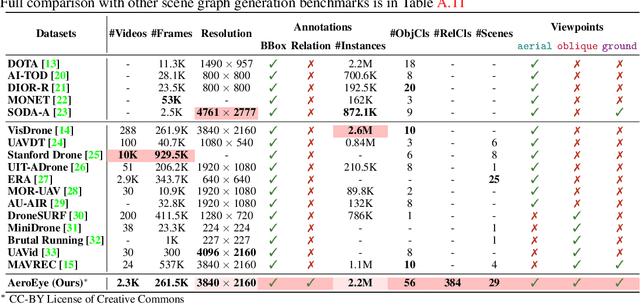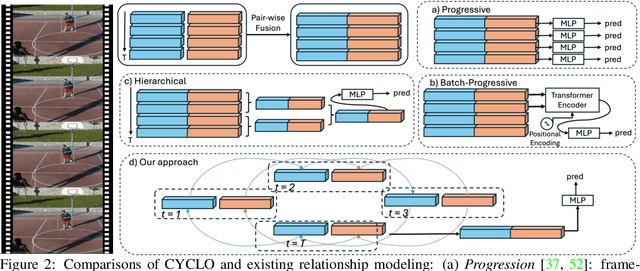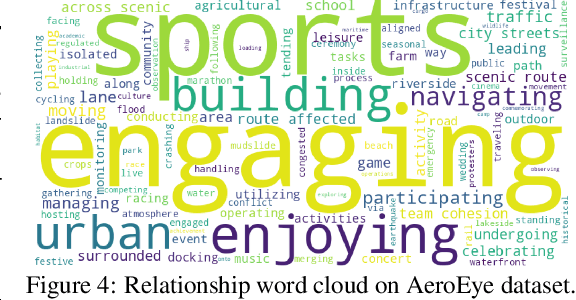Trong-Thuan Nguyen
HyperGLM: HyperGraph for Video Scene Graph Generation and Anticipation
Nov 27, 2024Abstract:Multimodal LLMs have advanced vision-language tasks but still struggle with understanding video scenes. To bridge this gap, Video Scene Graph Generation (VidSGG) has emerged to capture multi-object relationships across video frames. However, prior methods rely on pairwise connections, limiting their ability to handle complex multi-object interactions and reasoning. To this end, we propose Multimodal LLMs on a Scene HyperGraph (HyperGLM), promoting reasoning about multi-way interactions and higher-order relationships. Our approach uniquely integrates entity scene graphs, which capture spatial relationships between objects, with a procedural graph that models their causal transitions, forming a unified HyperGraph. Significantly, HyperGLM enables reasoning by injecting this unified HyperGraph into LLMs. Additionally, we introduce a new Video Scene Graph Reasoning (VSGR) dataset featuring 1.9M frames from third-person, egocentric, and drone views and supports five tasks: Scene Graph Generation, Scene Graph Anticipation, Video Question Answering, Video Captioning, and Relation Reasoning. Empirically, HyperGLM consistently outperforms state-of-the-art methods across five tasks, effectively modeling and reasoning complex relationships in diverse video scenes.
CYCLO: Cyclic Graph Transformer Approach to Multi-Object Relationship Modeling in Aerial Videos
Jun 03, 2024



Abstract:Video scene graph generation (VidSGG) has emerged as a transformative approach to capturing and interpreting the intricate relationships among objects and their temporal dynamics in video sequences. In this paper, we introduce the new AeroEye dataset that focuses on multi-object relationship modeling in aerial videos. Our AeroEye dataset features various drone scenes and includes a visually comprehensive and precise collection of predicates that capture the intricate relationships and spatial arrangements among objects. To this end, we propose the novel Cyclic Graph Transformer (CYCLO) approach that allows the model to capture both direct and long-range temporal dependencies by continuously updating the history of interactions in a circular manner. The proposed approach also allows one to handle sequences with inherent cyclical patterns and process object relationships in the correct sequential order. Therefore, it can effectively capture periodic and overlapping relationships while minimizing information loss. The extensive experiments on the AeroEye dataset demonstrate the effectiveness of the proposed CYCLO model, demonstrating its potential to perform scene understanding on drone videos. Finally, the CYCLO method consistently achieves State-of-the-Art (SOTA) results on two in-the-wild scene graph generation benchmarks, i.e., PVSG and ASPIRe.
HIG: Hierarchical Interlacement Graph Approach to Scene Graph Generation in Video Understanding
Dec 05, 2023Abstract:Visual interactivity understanding within visual scenes presents a significant challenge in computer vision. Existing methods focus on complex interactivities while leveraging a simple relationship model. These methods, however, struggle with a diversity of appearance, situation, position, interaction, and relation in videos. This limitation hinders the ability to fully comprehend the interplay within the complex visual dynamics of subjects. In this paper, we delve into interactivities understanding within visual content by deriving scene graph representations from dense interactivities among humans and objects. To achieve this goal, we first present a new dataset containing Appearance-Situation-Position-Interaction-Relation predicates, named ASPIRe, offering an extensive collection of videos marked by a wide range of interactivities. Then, we propose a new approach named Hierarchical Interlacement Graph (HIG), which leverages a unified layer and graph within a hierarchical structure to provide deep insights into scene changes across five distinct tasks. Our approach demonstrates superior performance to other methods through extensive experiments conducted in various scenarios.
SketchANIMAR: Sketch-based 3D Animal Fine-Grained Retrieval
Apr 12, 2023Abstract:The retrieval of 3D objects has gained significant importance in recent years due to its broad range of applications in computer vision, computer graphics, virtual reality, and augmented reality. However, the retrieval of 3D objects presents significant challenges due to the intricate nature of 3D models, which can vary in shape, size, and texture, and have numerous polygons and vertices. To this end, we introduce a novel SHREC challenge track that focuses on retrieving relevant 3D animal models from a dataset using sketch queries and expedites accessing 3D models through available sketches. Furthermore, a new dataset named ANIMAR was constructed in this study, comprising a collection of 711 unique 3D animal models and 140 corresponding sketch queries. Our contest requires participants to retrieve 3D models based on complex and detailed sketches. We receive satisfactory results from eight teams and 204 runs. Although further improvement is necessary, the proposed task has the potential to incentivize additional research in the domain of 3D object retrieval, potentially yielding benefits for a wide range of applications. We also provide insights into potential areas of future research, such as improving techniques for feature extraction and matching, and creating more diverse datasets to evaluate retrieval performance.
TextANIMAR: Text-based 3D Animal Fine-Grained Retrieval
Apr 12, 2023



Abstract:3D object retrieval is an important yet challenging task, which has drawn more and more attention in recent years. While existing approaches have made strides in addressing this issue, they are often limited to restricted settings such as image and sketch queries, which are often unfriendly interactions for common users. In order to overcome these limitations, this paper presents a novel SHREC challenge track focusing on text-based fine-grained retrieval of 3D animal models. Unlike previous SHREC challenge tracks, the proposed task is considerably more challenging, requiring participants to develop innovative approaches to tackle the problem of text-based retrieval. Despite the increased difficulty, we believe that this task has the potential to drive useful applications in practice and facilitate more intuitive interactions with 3D objects. Five groups participated in our competition, submitting a total of 114 runs. While the results obtained in our competition are satisfactory, we note that the challenges presented by this task are far from being fully solved. As such, we provide insights into potential areas for future research and improvements. We believe that we can help push the boundaries of 3D object retrieval and facilitate more user-friendly interactions via vision-language technologies.
 Add to Chrome
Add to Chrome Add to Firefox
Add to Firefox Add to Edge
Add to Edge